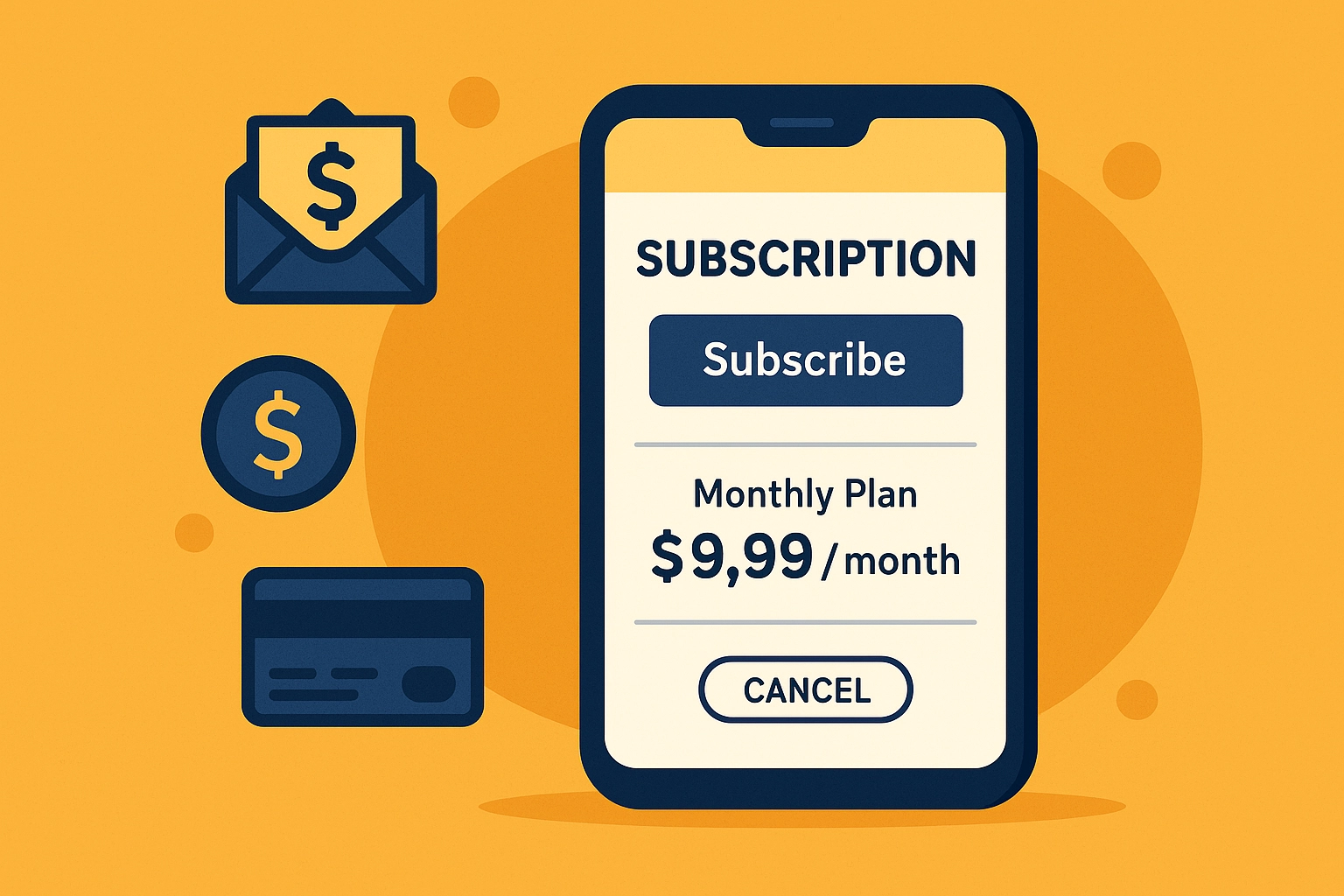Auto-Renewal Laws: What App Developers Need to Know About Subscription Compliance
Published 13th November, 2025 by Claire McGregor Subscription compliance in the United States is evolving rapidly. With New York’s updated auto-renewal law now in effect and many other states strengthening their own rules, app developers must rethink how they design, disclose, and manage subscription billing. This guide breaks down the latest regulations, what they mean for iOS and Android developers, how refunds work on the App Store versus Google Play, and why ongoing review monitoring is essential for subscription success.
Subscription compliance in the United States is evolving rapidly. With New York’s updated auto-renewal law now in effect and many other states strengthening their own rules, app developers must rethink how they design, disclose, and manage subscription billing. This guide breaks down the latest regulations, what they mean for iOS and Android developers, how refunds work on the App Store versus Google Play, and why ongoing review monitoring is essential for subscription success. What we cover:
- Auto-Renewal Laws Are Expanding Across the U.S., Not Just New York
- Why Developers Need a Universal Strategy
- Best Practices for Subscription Apps in 2025 and Beyond
- How Refunds Work on Apple vs. Google Play
- Refunds When External Payment Systems Are Used
- Why You Should Always Monitor App Review Sentiment Around Pricing and Subscriptions
- Final Thoughts on App Subscription Renewals
Want to monitor & track your app reviews?
Try Appbot free now, no credit card needed →Google Play has already issued a notice to developers about changes tied to New York’s new refund rights. Apple has not yet released a similar announcement, but the legal obligations apply to every subscription business operating in the U.S.
Because developers generally cannot identify a subscriber’s U.S. state, the most reliable strategy is to implement universal, legally aligned subscription best practices that work across every region and platform.
Auto-Renewal Laws Are Expanding Across the U.S., Not Just New York
New York’s recent update requires:
- Clear, advance notice of subscription price increases
- A simple opt-out mechanism
- Prorated refunds if users cancel within 14 days after choosing not to accept the higher price
Several U.S. states now have active or strengthened Automatic Renewal Laws (ARLs), including California, Colorado, Delaware, Illinois, Minnesota, Vermont, Virginia, and New York, with additional states expected to introduce similar regulations in the coming years.
Common requirements across ARLs:
- Highly visible subscription disclosures
- Clear and simple “click-to-cancel” options
- Advance notification of renewal or price changes
- Email confirmations and reminders
- Refund eligibility in certain scenarios
Transparent, user-centric subscription design is more important than ever.
Why Developers Need a Universal Strategy
State-by-state compliance is unrealistic for mobile apps or subscription businesses, especially when:
- App teams cannot determine a user’s state
- App store billing systems abstract location data
- User sentiment and perception matter as much as legal compliance
The safest and most scalable solution is to adopt broad subscription best practices that align with the strictest requirements.
Best Practices for Subscription Apps in 2025 and Beyond
Subscription UX Best Practices:
- Provide clear, upfront pricing and renewal terms
- Provide advance notice before price increases
- Offer an explicit opt-out when prices change
- Avoid dark patterns in subscription onboarding and cancellation flows
- Keep cancellation simple, ideally two or three steps
Operational Best Practices:
- Train support teams on refund expectations
- Keep App Store and Google Play subscription disclosures up to date
- Ensure backend systems can support the logic for prorated refunds
- Audit onboarding and billing documentation regularly
These improvements reduce legal risk, improve retention, and build user trust.
How Refunds Work on Apple vs. Google Play
When transactions are processed through Apple’s or Google Play’s own billing systems, refunds must always be handled by the respective platform; developers cannot override, replace, or directly issue these refunds. Refund handling differs significantly between the two major app platforms.
How Refunds Work on the Apple App Store
- Apple processes all refunds for App Store purchases
- Developers cannot issue refunds themselves
- Users request refunds through Apple’s Report a Problem portal
- Apple determines whether a refund is full, partial, or prorated
- Developers can provide consumption data via App Store Server APIs, which Apple may consider during refund evaluation
Apple controls the refund process; developers support it but cannot trigger refunds.
How Refunds Work on Google Play
- Users can request refunds through Google Play
- Developers can issue full or partial refunds directly in the Play Console
- Developers can automate refund workflows using the Google Play Developer API (orders.refund)
- Google may issue refunds automatically when required by policy or law
Google gives developers more flexibility and direct control than Apple.
Refunds When External Payment Systems Are Used
In certain regions, such as the European Union (EU), app developers are permitted to use external or third-party payment systems for subscriptions and in-app purchases. For purchases completed through external payment systems, the responsibility for issuing refunds shifts to the developer or the third-party payment provider, not Apple or Google. This requires app teams to maintain clear refund policies, ensure regional compliance, and provide user-friendly support workflows covering both platform-based and external payment-based transactions.
Why You Should Always Monitor App Review Sentiment Around Pricing and Subscriptions
Review sentiment related to pricing, billing, refunds, and subscriptions is one of the most important indicators of product health and, it needs to be monitored continuously, not only during pricing changes.
User perceptions around value, fairness, transparency, and renewal behavior can shift at any time. These shifts often appear in app reviews, before they show up in churn metrics or support queues.
Why continuous monitoring matters:
- Subscription satisfaction fluctuates over time
- Billing confusion or refund issues can surface unexpectedly
- Early detection prevents rating drops and conversion loss
- App store algorithms reward apps with stable, positive sentiment
- Reviews often reveal compliance risks (e.g., unclear disclosures, cancellation friction)
Signals to watch for:
- Increase in keywords such as refund, auto-renew, billing, charged, subscription, value, cancel
- Sudden increases in negative reviews
- Shifts in sentiment even without pricing changes
- Claims of unclear pricing or renewal terms
How Appbot helps:
Appbot's custom-built proprietary AI app review analysis tools automatically surface subscription-related trends by:
- Tracking review sentiment over time
- Automatically categorizes app reviews into Topics like Payments and Pricing
- Highlighting frequency of keywords and phrases related to pricing, subscriptions, and payments.
- Detecting subscription and payment issues after app updates or version releases
- Enabling easy sharing with product, support, and compliance teams with Integrations ensuring everyone sees the same signals early
Final Thoughts on App Subscription Renewals
The app subscription landscape is changing rapidly, driven by evolving auto-renewal laws and higher consumer expectations. By adopting universal subscription best practices, understanding platform-specific refund rules, and monitoring user sentiment continuously, app teams can reduce compliance risk, boost retention, and maintain strong App Store and Google Play performance.
Disclaimer: This article is for information only and isn’t legal advice. Laws and guidance on subscriptions change quickly; consult qualified counsel for requirements that apply to your apps.
Want to monitor & track your app reviews?
Try Appbot free now, no credit card needed →Where to from here?
- Explore the strategies employed by top grossing apps and learn how to achieve success.
- Master the art of writing an irresistible app store description that captures attention and drives downloads.
- Reply to app store reviews on the Apple and Google Play stores for happier customers and better star ratings.
- Dive into the secrets of creating addictive apps that keep users hooked and coming back for more.
About The Author

Claire is the Co-founder & Co-CEO of Appbot. Claire has been a product manager and marketer of digital products, from mobile apps to e-commerce sites and SaaS products for the past 15 years. She's led marketing teams to build multi-million dollar revenues and is passionate about growth and conversion optimization. Claire loves to work directly with the world's top app companies delivering tools to help them improve their apps. You can connect with her on LinkedIn.
Enjoying the read? You may also like these
 The Global Rise of Age Verification for Apps: What Devs Need to Know About Google & Apple APIs
The Global Rise of Age Verification for Apps: What Devs Need to Know About Google & Apple APIs Age verification is going mainstream. Learn how Apple’s Declared Age Range API and Google’s Play Age Signals API help developers meet new laws in Texas, Utah, California, Australia, Japan, and beyond.
Learn how Apple’s Product Page Optimization lets you A/B test app store screenshots, videos, and icons to improve conversion rates and app installs.
Age verification is going mainstream. Learn how Apple’s Declared Age Range API and Google’s Play Age Signals API help developers meet new laws in Texas, Utah, California, Australia, Japan, and beyond.
Great app ideas don’t start with features - they start with solving problems. Learn how to uncover, validate, and act on everyday pain points that lead to successful apps.


